Refer to our Texas Go Math Grade 3 Answer Key Pdf to score good marks in the exams. Test yourself by practicing the problems from Texas Go Math Grade 3 Lesson 9.4 Answer Key Partial Products.
Texas Go Math Grade 3 Lesson 9.4 Answer Key Partial Products
Essential Question
How can you model and record the products of 2-digit and 1-digit numbers?
Answer:
We can model and record the products of 2-digit and 1-digit numbers by different ways like arranging them vertically and doing multiplication or expanded form.
Explanation:
Way:1:
Step I: Arrange the numbers vertically.
Step II: First multiply the digit at the ones place by 2.
2 × 4 = 8 ones.
Step III: Now multiply the digit at the tens place by 2.
2 × 3 = 6 tens.
Way:2. Multiply 20 by 3 by using expanded form
Solution:
20 → 2 tens + 0 ones
× 3 → × 3
6 tens + 0 ones
= 60 + 0
= 60
Therefore, 20 × 3 = 60
Unlock the Problem
For a field trip to the science center, there are 4 buses from Maddie’s school with 16 students on each bus. How many students are going on the field trip?
4 × 16 = ___
When you multiply the tens and the ones separately and then add the products, you are finding partial products.
One Way
Make an array with base-ten blocks to model the problem.
Step 1
Use 1 ten 6 ones to show 16. Make 4 rows of l6 to show 4 × 16.

Step 2
Combine the tens and the ones to find the product.

Another Way
Draw an array on grid paper.
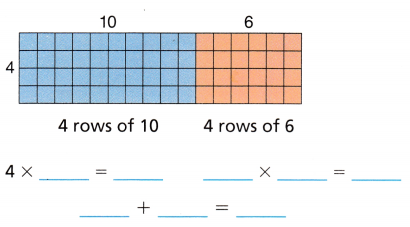
So, ___ students are going on the field trip.
Answer:
Number of buses from Maddie’s school = 4.
Number of students on each bus = 16.
Number of students are going on the field trip = Number of buses from Maddie’s school × Number of students on each bus
= 4 × 16
= (4 × 10) + (4 × 6)
= 40 + 24
= 64.
One Way:

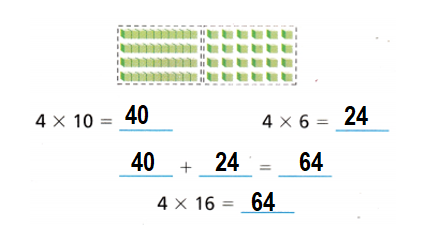
Another way:

Connect Record Multiplication.
You can use what you have learned about the Distributive Property to find products of 2-digit and 1-digit numbers.

Shade the model to show each step.

Answer:
Product: 23 × 6 = 138.
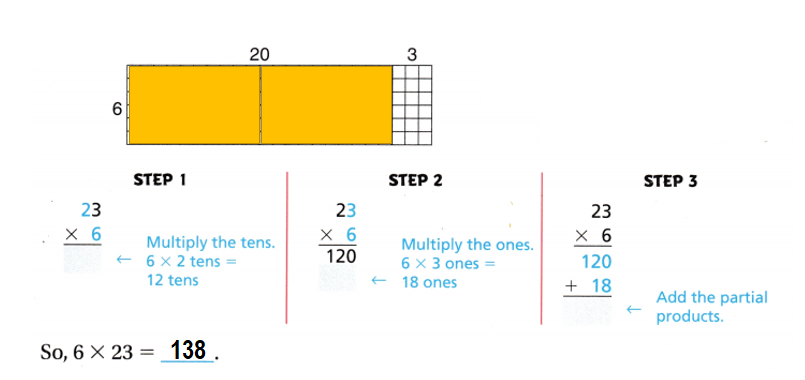
Explanation:
23 × 6 = ???
Multiply the tens :
23 × 6 = 120.
Multiply the ones :
23 × 6 = 18.
Product:
23 × 6 = 120 + 18 = 138.
Math Talk
Mathematical Processes
Why you record the tens first in step 1.
Answer:
We record tens place in step 1 because the place value of it highest.
Explanation:
Tens place first we multiply because its the highest place and covers both ones place also.
Share and Show
Question 1.
Model 5 × 18 with base-ten blocks or grid paper. Use paper and pencil to record your multiplication.
Answer:
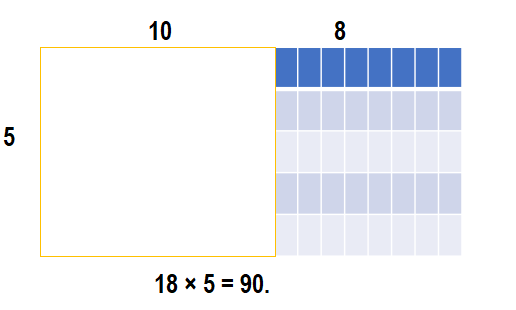
Explanation:
Number of rows = 5.
Number of columns = 18.
Product = Number of rows × Number of columns
= 5 × 18
= (5 × 10) + (5 × 8)
= 50 + 40
= 90.
Find the product.
Question 2.
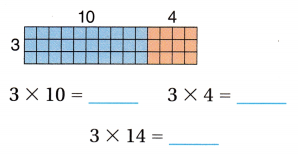
Answer:
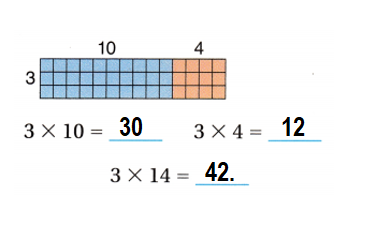
Explanation:
Multiply the number of rows:
3 × 10 = 30.
3 × 4 = 12
Add the rows and multiply:
3 × (10 + 4) = 30 + 12
3 × 14 = 42.
Question 3.

Answer:

Explanation:
Multiply the number of rows:
2 × 10 = 20.
2 × 8 = 16
Add the rows and multiply:
2 × (20 + 8) = 20 + 16
2 × 18 = 36.
Find the product. Use base-ten blocks or draw an array to help.
Question 4.
14 × 4
Answer:
Product: 14 × 4 = 56.
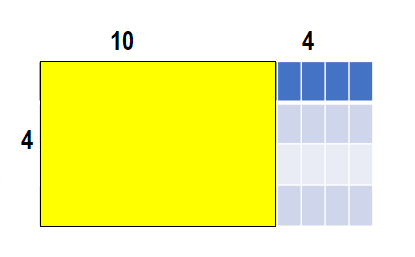
Explanation:
Number of rows = 4.
Number of columns = 14.
Product = Number of rows × Number of columns
= 4 × 14
= (4 × 10) + (4 × 4)
= 40 + 16
= 56.
Question 5.
17 × 3
Answer:
Product: 17 × 3 = 51.
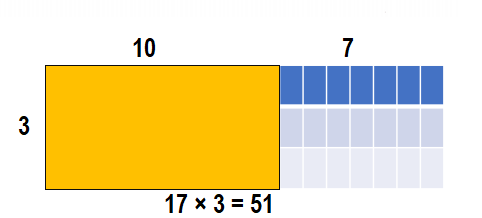
Explanation:
Number of rows = 3.
Number of columns = 17.
Product = Number of rows × Number of columns
= 3 × 17
= (3× 10) + (3 × 7)
= 30 + 21
= 51.
Question 6.
52 × 6
Answer:
Product: 52 × 6 = 312.

Explanation:
Number of rows = 6.
Number of columns = 52.
Product = Number of rows × Number of columns
= 6 × 52
= (6 × 10) + (6 × 10) + (6 × 10) + (6 × 10) + (6 × 10) + (6 × 2)
= 60 + 60 + 60 + 60 + 60 + 12
= 120 + 60 + 60 + 60 + 12
= 180 + 60 + 60 + 12
= 240 + 60 + 12
= 300 + 12
= 312.
= 90.
Question 7.
41 × 7
Answer:
Product: 41 × 7 = 287.
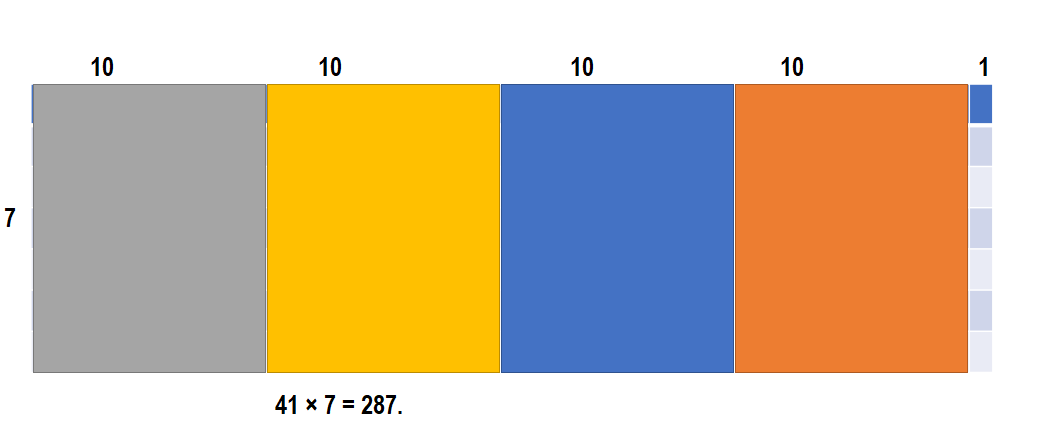
Explanation:
Number of rows = 7.
Number of columns = 41.
Product = Number of rows × Number of columns
= 7 × 41
= (7 × 10) + (7 × 10) + (7 × 10) + (7 × 10) + (7 × 1)
= 70 + 70 + 70 + 70 + 7
= 140 + 70 + 70 + 7
= 210 + 70 + 7
= 280 + 7
= 287.
Problem Solving
Use the table for 8-13.
Question 8.
Representations What is the cost of 3 Purple Lilac trees?

Answer:
Cost of 3 Purple Lilac trees = $87.
Explanation:
Number of Purple Lilac trees = 3.
Cost of each Purple Lilac trees = $29.
Cost of 3 Purple Lilac trees = Number of Purple Lilac trees × Cost of each Purple Lilac trees
= 3 × $29
= (3 × $10) + (3 × $10) + (3 × $9)
= $30 + $30 + $27
= $60 + $27
= $87.
Question 9.
Multi-Step What is the cost of 2 Magnolia trees and 1 American Redbud?
Answer:
Cost of 2 Magnolia trees and 1 American Redbud = $137.
Explanation:
Cost of each Magnolia trees = $59.
Number of Magnolia trees = 2.
Cost of 2 Magnolia trees = Cost of each Magnolia trees × Number of Magnolia trees
= $59 × 2
= ($10 × 2) + ($10 × 2) + ($10 × 2) + ($10 × 2) + ($10 × 2) + ($9 × 2)
= $20 + $20 + $20 + $20 + $20 + $18
= $40 + $20 + $20 + $20 + $18
= $60 + $20 + $20 + $18
= $80 + $20 + $18
= $100 + $18
= $118.
Cost of each American Redbud = $19.
Number of American Redbud = 1.
Cost of 1 American Redbud = Cost of each American Redbud × Number of American Redbud
= $19 × 1
= $19.
Cost of 2 Magnolia trees and 1 American Redbud = Cost of 2 Magnolia trees + Cost of 1 American Redbud
= $118 + $19
= $137.
Question 10.
H.O.T. Multi-Step What is the difference in cost of 3 Crepe Myrtle trees and 4 Purple Lilacs?

Answer:
$101 is the difference in cost of 3 Crepe Myrtle trees and 4 Purple Lilacs.
Explanation:
Cost of each Purple Lilac trees = $29.
Actual cost of 4 Purple Lilacs = Cost of each Purple Lilac trees × 4
= $29 × 4
= ($10 × 4) + ($10 × 4) + ($9 × 4)
= $40 + $40 + $36
= $80 + $36
= $116.
Discounted for each Purple Lilacs = $25.
Discounted for each Purple Lilacs = $25 × 4
= ($10 × 4) + ($10 × 4) + ($5 × 4)
= $40 + $40 + $20
= $80 + $20
= $100.
Cost of 4 Purple Lilacs = Cost of 4 Purple Lilacs – Discounted for each Purple Lilacs
= $116 – $100
= $16.
Cost of each Crepe Myrtle trees = $39.
Actual cost of 3 Crepe Myrtle trees = Cost of each Crepe Myrtle trees × 3
= $39 × 3
= ($10 × 3) + ($10 × 3) + ($10 × 3) + ($9 × 3)
= $30 + $30 + $30 + $27
= $60 + $30 + $27
= $90 + $27
= $117.
Difference in cost of 3 Crepe Myrtle trees and 4 Purple Lilacs = Actual cost of 3 Crepe Myrtle trees – Cost of 4 Purple Lilacs
= $117 – $16
= $101.
Question 11.
Pose a Problem Look back at Problem 10. Write a similar problem by changing the number and type of trees. Then solve the problem.
Answer:
Question: What is the difference in cost of 3 Magnolia trees and 2 American Redbud?
Solution: $139 is the difference in cost of 3 Magnolia trees and 2 American Redbud.
Explanation:
Cost of Magnolia trees = $59.
Cost of 3 Magnolia trees = 3 × $59
= (3 × 10) + (3 × 10) + (3 × 10) + (3 × 10) + (3 × 10) + (3 × 9)
= 30 + 30 + 30 + 30 + 30 + 27
= 60 + 30 + 30 + 30 + 27
= 90 + 30 + 30 + 27
= 120 + 30 + 27
= 150 + 27
= $177.
Cost of American Redbud = $19.
Cost of 2 American Redbud = 2 × $19
= (2 × 10) + (2 × 9)
= 20 + 18
= $38.
Difference:
Cost of 3 Magnolia trees – Cost of 2 American Redbud
= $177 – $38
= $139.
Question 12.
H.O.T. Multi-Step How much will you save by buying 6 American Redbuds at the discounted price instead of at the regular price?
Answer:
$24 will be saved by buying 6 American Redbuds at the discounted price instead of at the regular price.
Explanation:
Cost of American Redbuds = $19.
Regular cost of 6 American Redbuds = 6 × $19
= (6 × 10) + (6 × 9)
= 60 + 54
= $114.
Cost of discounted price per tree American Redbuds = $15.
Cost of discounted price per tree 6 American Redbuds = 6 × $15
= (6 × 10) + (6 × 5)
= 60 + 30
= $90.
Cost of 6 American Redbuds after the discounted price = Regular cost of 6 American Redbuds – Cost of discounted price per tree 6 American Redbuds
= $114 – $90
= $24.

Question 13.
write Math What’s the Question? Mario multiplied by 4 and used the information in the table. The answer is $204.
Answer:
No, answer is not correct because Mario multiplied by 4 and used the information in the table, the answer is $84 not $204.
Explanation:

Cost of Magnolia Grandiflora = $59.
Cost of America Redbud = $19.
Cost of Zuni Crepe Myrtle = $39.
Cost of Purple Lilac = $29.
Actual price of all trees = Cost of Magnolia Grandiflora + Cost of America Redbud + Cost of Zuni Crepe Myrtle + Cost of Purple Lilac
= $59 + $19 + $39 + $29
= $78 + $39 + $29
= $117 +$29
= $146.
Discounted price per each Magnolia Grandiflora tree (4 or more) = $51.
Discounted price per each America Redbud (4 or more) = $15.
Discounted price per each Zuni Crepe Myrtle (4 or more) = $34.
Discounted price per each Purple Lilac (4 or more) = $25.
Total discounted price of all trees (4 or more) = Discounted price per each Magnolia Grandiflora tree (4 or more) + Discounted price per each America Redbud (4 or more) + Discounted price per each Zuni Crepe Myrtle (4 or more) + Discounted price per each Purple Lilac (4 or more)
= $51 + $15 + $34 + $25
= $66 + $34 + $25
= $100 + $25
= $125.
Mario multiplied by 4.
=> Total price of all trees = Actual price of all trees – Total discounted price of all trees (4 or more)
= ($146 – $125) × 4
= $21 × 4
= ($10 × 4) + ($10 × 4) + ($1 × 4)
= $40 + $40 + $4
= $80 + $4
= $84.
Daily Assessment Task
Fill in the bubble for the correct answer choice.
Question 14.
There are 26 teams in the spring baseball league. Each team needs 5 parent volunteers. How many volunteers do the teams need?
(A) 31
(B) 30
(C) 100
(D) 130
Answer:
Number of volunteers do the teams needs = 130.
(D) 130.
Explanation:
Number of teams in the spring baseball league = 26.
Number of parent volunteer each team needs = 5.
Number of volunteers do the teams needs = Number of teams in the spring baseball league × Number of parent volunteer each team needs
= 26 × 5
= (10 × 5) + (10 × 5) + (6 × 5)
= 50 + 50 + 30
= 100 + 30
= 130.
Question 15.
Use Tools Richmond Elementary School has 5 reading classes. Each class sends 19 students to the school spelling bee. How many students are in the school spelling bee?

(A) 24
(B) 45
(C) 95
(D) 545
Answer:
Number of students are in the school spelling bee = 95.
(C) 95.
Explanation:
Number of reading classes Richmond Elementary School has = 5.
Number of students each class sends to the school spelling bee = 19.
Number of students are in the school spelling bee = Number of reading classes Richmond Elementary School has × Number of students each class sends to the school spelling bee
= 5 × 19
= (5 × 10) + (5 × 9)
= 50 + 45
= 95.
Question 16.
Multi-Step Kyle lives 17 miles away from Main City Park, He goes to the park and then back home 3 times each week. How many miles does Kyle travel to and from Main City Park each week?
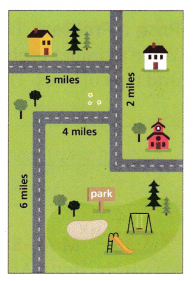
(A) 102 miles
(B) 17 miles
(C) 34 miles
(D) 912 miles
Answer:
Number of miles Kyle travel to and from Main City Park each week = 102.
(A) 102 miles.
Explanation:
Number of miles away from Main City Park Kyle lives = 17.
Number of times he goes to the park and then back home each week = 3.
Number of miles Kyle travel to and from Main City Park each week = (2 × Number of miles away from Main City Park Kyle lives) × Number of times he goes to the park and then back home each week
= (2 × 17) × 3
=[(10 × 2) + (7 × 2)] × 3
= (20 + 14) × 3
= 34 × 3
= (3 × 10) + (3 × 10) + (3 × 10) + (3 × 4)
= 30 + 30 + 30 + 12
= 60 + 30 + 12
= 90 + 12
= 102.
Texas Test Prep
Question 17.
Mr. Perry bought 6 gallons of juice for a class party. Each gallon has 16 cups. ¡f3 cups of juice were left over, how many cups did students drink?
(A) 48 cups
(B) 9 cups
(C) 93 cups
(D) 13 cups
Answer:
Number of cups students drink = 93.
(C) 93 cups.
Explanation:
Number of gallons of juice for a class party Mr. Perry bought = 6.
Number of cups each gallon has = 16.
Number of cups of juice were left over = 3.
Number of cups students drink = (Number of gallons of juice for a class party Mr. Perry bought × Number of cups each gallon has) – Number of cups of juice were left over
=(6 × 16) – 3
= [(6 × 10) + (6 × 6)] – 3
= (60 + 36)- 3
= 96 – 3
= 93.
Texas Go Math Grade 3 Lesson 9.4 Homework and Practice Answer Key
Find the product.
Question 1.
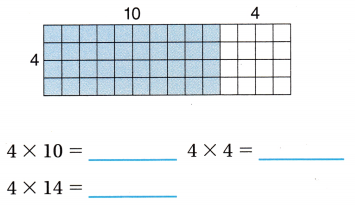
Answer:
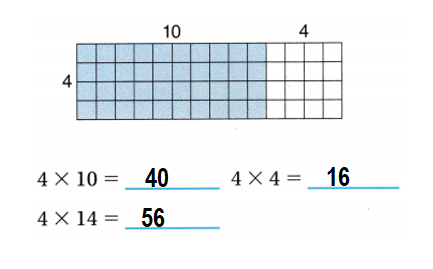
Explanation:
Number of rows = 4.
Number of columns = 14.
Product = Number of columns × Number of rows
= 14 × 4
= (10 × 4) + (4 × 4)
= 40 + 16
= 56.
Question 2.
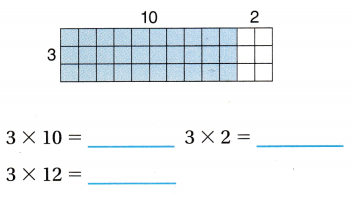
Answer:
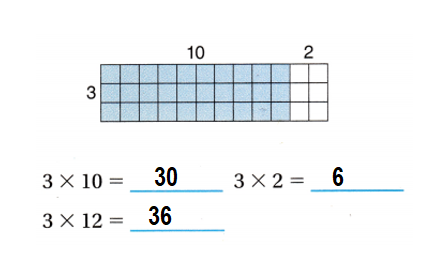
Explanation:
Number of columns = 12.
Number of rows = 3.
Product = Number of columns × Number of rows
= 12 × 3
= (10 × 3) + (2 × 3)
= 30 + 6
= 36.
Find the product. Draw an array to help.
Question 3.

Answer:
Product = 23 × 6 = 138.
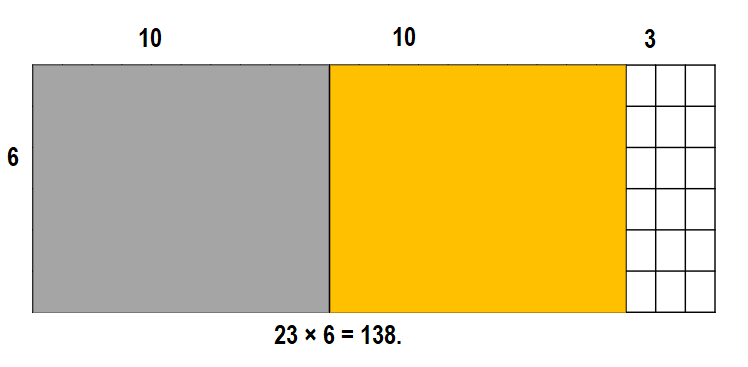
Explanation:
Number of columns = 23.
Number of rows = 6.
Product = Number of columns × Number of rows
= 23 × 6
= (10 × 6) + (10 × 6) + (3 × 6)
= 60 + 60 + 18
= 120 + 18
= 138.
Question 4.

Answer:
Product = 18 × 9 = 162.

Explanation:
Number of columns = 18.
Number of rows = 9.
Product = Number of columns × Number of rows
= 18 × 9
= (10 × 9) + (8 × 9)
= 90 + 72
= 162.
Question 5.

Answer:
Product = 32 × 4 = 128.

Explanation:
Number of columns = 32.
Number of rows = 4.
Product = Number of columns × Number of rows
= 32 × 4
= (10 × 4) + (10 × 4) + (10 × 4) + (2 × 4)
= 40 + 40 + 40 + 8
= 80 + 40 + 8
= 120 + 8
= 128.
Question 6.

Answer:
Product: 75 × 3 = 225.
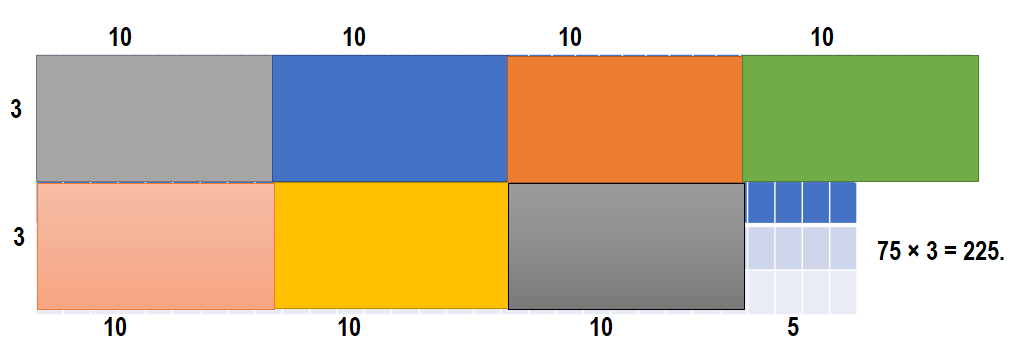
Explanation:
Number of columns = 75.
Number of rows = 3.
Product = Number of columns × Number of rows
= 75 × 3
= (10 × 3) + (10 × 3) + (10 × 3) + (10 × 3) +(10 × 3) + (10 × 3) +(10 × 3) + (5 × 3)
= 30 + 30 + 30 + 30 + 30 + 30 + 30 + 15
= 60 + 30 + 30 + 30 + 30 + 30 + 15
= 90 + 30 + 30 + 30 + 30 + 15
= 120 + 30 + 30 + 30 + 15
= 150 + 30 + 30 + 15
= 180 + 30 + 15
= 210 + 15
= 225.
Problem Solving
Use the table for 7-9.
Question 7.
If a cow eats 43 pounds of feed in one week, how many pounds do 7 cows eat?

Answer:
Number of pounds of feed in one week 7 cows eats = 301.
Explanation:
Number of pounds of feed in one week a cow eats = 43.
Number of cows = 7.
Number of pounds of feed in one week 7 cows eats = Number of pounds of feed in one week a cow eats × Number of cows
= 43 × 7
= (10 × 7) + (10 × 7) + (10 × 7) + (10 × 7) + (3 × 7)
= 70 + 70 + 70 + 70 + 21
= 140 + 70 + 70 + 21
= 210 + 70 + 21
= 280 + 21
= 301.
Question 8.
There are 3 female hogs and 5 male hogs. How many pounds of feed do they eat altogether?
Answer:
Number of pounds of feed they eat altogether = 296.
Explanation:
Number of female hogs = 3.
Number of male hogs = 5.
Number of pounds hogs eat = 37.
Number of pounds of feed they eat altogether = (Number of female hogs + Number of male hogs) Number of pounds hogs eat
= (3 + 5) 37
= 8 × 37
= (8 × 10) + (8 × 10) + (8 × 10) + (8 × 7)
= 80 + 80 + 80 + 56
= 160 + 80 + 56
= 240 + 56
= 296.
Question 9.
How many more pounds of feed do 5 steer eat than 5 cows?
Answer:
40 more pounds of feed 5 steer eat than 5 cows.
Explanation:
Number of steer = 5.
Number of cows = 5.
Number of pounds steer eat = 51.
Number of pounds cows eat = 43.
Total number of pounds 5 steer eat = Number of steer × Number of pounds steer eat
= 5 × 51
= (5 × 10) + (5 × 10) + (5 × 10) + (5 × 10) + (5 × 10) + (5 × 1)
= 50 + 50 + 50 + 50 + 50 + 5
= 100 + 50 + 50 + 50 + 5
= 150 + 50 + 50 + 5
= 200 + 50 + 5
= 250 + 5
= 255.
Total number of pounds 5 cows eat = Number of cows × Number of pounds cows eat
= 5 × 43
= (5 × 10) + (5 × 10) + (5 × 10) + (5 × 10) + (5 × 3)
= 50 + 50 + 50 + 50 + 15
= 100 + 50 + 50 + 15
= 150 + 50 + 15
= 200 + 15
= 215.
Difference:
Total number of pounds 5 steers eat – Total number of pounds 5 cows eat
= 255 – 215
= 40.
Texas test Prep
Lesson Check
Fill in the bubble completely to show your answer.
Question 10.
The soccer league has 28 teams. Each team has 9 players. How many players are there in all?
(A) 72
(B) 152
(C) 289
(D) 252
Answer:
Number of players are there in all = 252.
(D) 252.
Explanation:
Number of teams soccer league has = 28.
Number of players each team has = 9.
Number of players are there in all = Number of teams soccer league has × Number of players each team has
= 28 × 9
= (10 × 9) + (10 × 9) + (8 × 9)
= 90 + 90 + 72
= 180 + 72
= 252.
Question 11.
An apple orchard has 8 rows of trees. Each row has 34 trees. How many trees are in the orchard?
(A) 272
(B) 332
(C) 172
(D) 348
Answer:
Number of trees are in the orchard = 272.
(A) 272.
Explanation:
Number of rows of trees an apple orchard has = 8.
Number of trees each row has = 34.
Number of trees are in the orchard = Number of rows of trees an apple orchard has × Number of trees each row has
= 8 × 34
= (8 × 10) + (8 × 10) + (8 × 10) + (8 × 4)
= 80 + 80 + 80 + 32
= 160 + 80 + 32
= 240 + 32
= 272.
Question 12.
On a school trip, there are 4 buses of students. Each bus holds 58 students. How many students go on the school trip?
(A) 458
(B) 132
(C) 532
(D) 232
Answer:
Number of students go on the school trip = 232.
(D) 232.
Explanation:
Number of buses of students on a school trip = 4.
Number of students each bus holds = 58.
Number of students go on the school trip = Number of buses of students on a school trip × Number of students each bus holds
= 4 × 58
= (4 × 10) + (4 × 10) + (4 × 10) + (4 × 10) + (4 × 10) + (4 × 8)
= 40 + 40 + 40 + 40 + 40 + 32
= 80 + 40 + 40 + 40 + 32
= 120 + 40 + 40 + 32
= 160 + 40 + 32
= 200 + 32
= 232.
Question 13.
A train travels 47 miles between two cities. If the train makes 4 trips in one day, how many miles does it travel?
(A) 167 miles
(B) 128 miles
(C) 188 miles
(D) 168 miles
Answer:
Number of miles it travel = 188.
(C) 188 miles.
Explanation:
Number of miles between two cities a train travels = 47.
Number of trips in one day a train makes = 4.
Number of miles it travel = Number of miles between two cities a train travels × Number of trips in one day a train makes
= 47 × 4
= 188.
Question 14.
Multi-Step Luz makes an array of 6 rows of 27 cubes. If he has 9 cubes left over, how many cubes did he have to start with?
(A) 171
(B) 243
(C) 162
(D) 153
Answer:
Number of cubes he have to start with = 171.
(A) 171.
Explanation:
Number of rows Luz makes an array = 6.
Number of cubes = 27.
Number of cubes left over = 9.
Number of cubes he have to start with = (Number of rows Luz makes an array × Number of cubes ) + Number of cubes left over
= (6 × 27) + 9
= 162 + 9
= 171.
Question 15.
Multi-Step There are 8 trays of sandwiches at a picnic. Each tray holds 22 sandwiches. If 12 sandwiches are left over, how many sandwiches were eaten?
(A) 176
(B) 164
(C) 188
(D) 174
Answer:
Number of sandwiches were eaten = 164.
(B) 164.
Explanation:
Number of trays of sandwiches at a picnic = 8.
Number of sandwiches each tray holds = 22.
Number of sandwiches are left over = 12.
Number of sandwiches were eaten = (Number of trays of sandwiches at a picnic × Number of sandwiches each tray holds) + Number of sandwiches are left over
= (8 × 22) – 12
= 176 – 12
= 164.